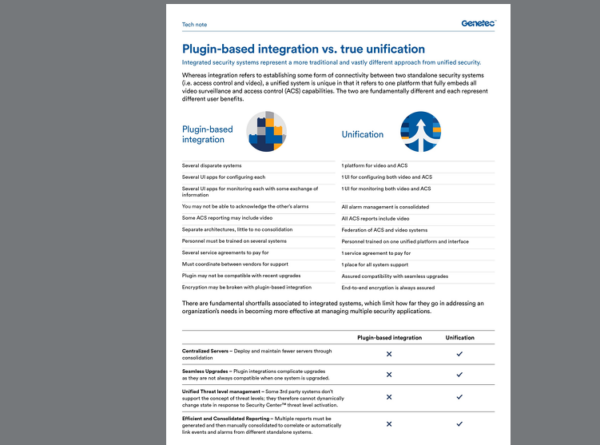
Andrew Elvish, VP Marketing, Genetec, Inc.
Modern security environments include an ever-expanding number of devices and systems. When these powerful tools are added piece by piece, the result is often a set of disparate systems with limited communication and interoperability.
Security professionals should think carefully before building the backbone of their security on disparate systems because it can be risky. The core functions of your security solution work best when unified.
Unification makes the job of securing people, buildings, and assets easier and more efficient. It improves and enables the flow of data across security activities and operations. And it’s designed to adapt to your organization’s needs over time.
Unification vs integration
There’s a lot of confusion about ‘unification’ and ‘integration.’ The two words are often used in similar ways, so it’s not surprising that people sometimes think they mean the same thing.
Integration is complementary to unification, but it doesn’t provide the same seamless experience. Integration permits products and software produced by different companies to work together. For example, an integrated system may connect an access control system produced by one vendor to a video management system from another provider. It becomes more difficult when one company buys (or is bought by) another company, priorities may change, and the “integration” you relied on for your system stops working as you expected.
An integrated system with many independent connections makes consolidating a large amount of data time-consuming. Keeping the system up to date is also more complex because each component needs to be maintained and updated separately.
On the other hand, a unified system creates a strong foundation from the start. It entails a suite of products developed as one unit. The system is designed from the first line of code to bring all security applications together in one single interface. Data flows seamlessly through the platform, and all components work together so you achieve a comprehensive physical security experience.
Resiliency through unification
When you integrate technologies produced by different companies, their destinies aren’t managed together. This makes an integrated solution more fragile. More variables can impact the functioning of the system.
System updates happen at different times, and sometimes an update to one solution may break a connection or introduce a conflict that affects functionality. Providers may also choose to discontinue support for an integration, limiting your system capabilities.
A unified solution, however, is updated as a whole platform. Updates and patches are made across multiple systems at one time. You can turn on or off different modules, but you can’t break the connections – because there aren’t any. You may also implement tools that monitor the health of all of your systems, reducing the risk of cybersecurity breaches
The more complex the company, the riskier it is to integrate technologies without a strong unified foundation. Multinational companies with lots of employees or many assets to protect as well as organizations operating in sensitive industries, such as airports and critical infrastructure, need performance they can depend on. They look for providers that actively monitor and respond to emerging cybersecurity threats and prioritize a unified resilient solution.
A better experience for operators
When all your physical security activities, functions, and data originate from within the same system, you can harness the flow of data across your security activities. This makes it easier and more efficient to secure people, buildings, and assets while supporting operational efficiencies.
One platform and one user interface enhance the operator experience and empower them to make informed decisions more quickly and effectively. Adding new technologies to a unified platform doesn’t require your operators to learn new software or toggle between different screens. Everything is managed within one interface.
Instead of having to train operators on multiple systems, your team can learn one set of commands and procedures. This decreases onboarding time, saving you time and resources. After new staff are trained, a unified system can also orchestrate response and automation rules to guide operators when something happens. Whether they need to make a phone call, turn off a device, monitor a mustering point, access a live video feed, or trigger an alarm, they can be guided step by step while operating within the same platform.
Likewise, keeping many integrations up to date takes energy and time. As a result, the long-term maintenance cost of a complex integrated system can be significant. Systems become error-prone for operators. When updating software frequently results in tech headaches due to broken integrations, some users put off installing upgrades and patches for fear of breaking the system. This can introduce cybersecurity vulnerabilities that put the whole organization at risk.
Choosing a system based on current and future goals
With all this talk of integration and unification, you might wonder if it would be better to pick one provider and stick with their proprietary solution from edge to core. Some companies offer a temptingly low up-front price to sign on to a solution that locks you in to buying devices that only work with their software.
The downside? If you change your mind later, you can’t switch software providers without also changing all the proprietary hardware. You’re also limited only to the menu of devices offered by that company, whether or not they’re the best fit for your needs.
Instead, look for a unified, open architecture software partner who works with a broad array of technology partners and supports devices from multiple manufacturers. Choosing a unified platform doesn’t mean you’re stuck with one solution. It’s actually the opposite.
Within a unified, open system, various devices from different manufacturers are controlled and managed within one platform. You pick the solutions that best meet your needs. You may decide to choose one or more security solutions to address today’s needs, knowing you can expand your system over time to meet new challenges. All without starting from scratch every few years because of compatibility issues.
No one wants to be locked into old technology. When you choose a unified, open security platform, you can gain a complete security view that empowers your team to effectively protect your business while staying open to exciting possibilities in the future.

Andrew Elvish:
A senior technology marketing executive with a proven track-record in global high-end entertainment, media, and B2B technology markets. Strongly process and data driven, with core skills in building high-performance teams across Marketing, Communication, Product Marketing and Customer Experience domains.

Genetec develops solutions designed to improve security, intelligence, and operations for enterprises, governments, and the communities in which we live. Its flagship product, Security Center, is an open-architecture platform that unifies IP-based video surveillance, access control, automatic license plate recognition (ALPR), communications, and analytics. visit: genetec.com
See more articles on: Genetec
Source: genetec.com
